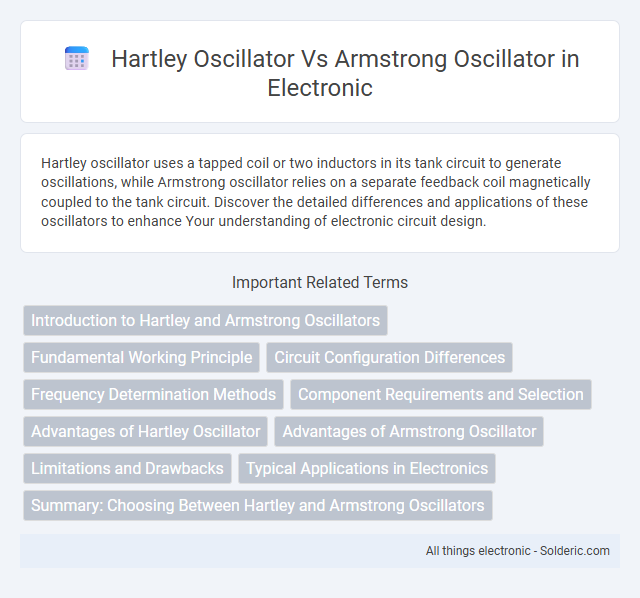Hartley oscillator uses a tapped coil or two inductors in its tank circuit to generate oscillations, while Armstrong oscillator relies on a separate feedback coil magnetically coupled to the tank circuit. Discover the detailed differences and applications of these oscillators to enhance Your understanding of electronic circuit design.
Comparison Table
| Feature | Hartley Oscillator | Armstrong Oscillator |
|---|---|---|
| Oscillator Type | LC Oscillator | LC Oscillator |
| Frequency Determining Network | Two inductors (or tapped inductor) and one capacitor | One inductor and one capacitor with a feedback coil |
| Feedback Method | Voltage feedback from inductive divider | Current feedback via separate feedback coil |
| Frequency Formula | f = 1 / (2p (C * L_eq)), L_eq = L1 + L2 + 2M | f = 1 / (2p (L * C)) |
| Frequency Stability | Moderate, depends on inductor quality | Generally higher frequency stability |
| Common Applications | RF signal generation, tuning circuits | High frequency oscillators, radio transmitters |
| Circuit Complexity | Simple design with tapped coil | Requires separate feedback coil, more complex |
| Output Waveform | Sinusoidal waveform | Sinusoidal waveform |
Introduction to Hartley and Armstrong Oscillators
Hartley and Armstrong oscillators are fundamental electronic circuits used to generate sinusoidal waveforms at specific frequencies. The Hartley oscillator employs a tapped inductor or two inductors in series with a capacitor to provide the necessary feedback for oscillation, while the Armstrong oscillator uses a separate feedback coil magnetically coupled to the tank circuit. Understanding the design differences between these oscillators helps optimize Your choice for frequency stability and circuit complexity in signal generation applications.
Fundamental Working Principle
The Hartley oscillator generates oscillations using a combination of an LC tank circuit with a tapped coil or two inductors in series, providing feedback through the coil tap to sustain the signal. The Armstrong oscillator, also known as a feedback or regenerative oscillator, employs a separate feedback coil inductively coupled to the tank circuit to maintain continuous oscillations. Understanding the fundamental working principle of these oscillators helps you choose the appropriate design for stable frequency generation in radio and communication circuits.
Circuit Configuration Differences
The Hartley oscillator uses a single tapped inductor or two inductors in series to provide feedback, forming an LC circuit with a capacitor, while the Armstrong oscillator employs a separate feedback coil magnetically coupled to the tank circuit. Hartley oscillator's feedback network is integrated within the tank circuit, enabling simpler design and easier frequency tuning through the inductor tap. Armstrong oscillator separates the feedback path from the tank circuit, typically offering better isolation and frequency stability but with increased circuit complexity.
Frequency Determination Methods
Hartley oscillator determines frequency through a tapped inductive coil in its LC tank circuit, where the ratio of inductance values directly influences the oscillation frequency. Armstrong oscillator uses separate inductive and capacitive components with a tickler coil to provide feedback, relying on mutual inductance for frequency stabilization. Your choice depends on the ease of tuning and stability requirements tied to each design's frequency determination method.
Component Requirements and Selection
Hartley oscillator primarily relies on two inductors and a capacitor, offering ease in tuning since the inductors' inductance values can be varied for frequency adjustment, making component selection straightforward for a wide range of frequencies. Armstrong oscillator uses a single tuned LC circuit for feedback along with a separate RF coil for feedback coupling, requiring careful selection of coil parameters to ensure stable oscillation and maintaining the desired frequency. Your choice of oscillator depends on component availability and tuning precision, with Hartley favored for simpler inductive components and Armstrong better suited for circuits needing feedback isolation.
Advantages of Hartley Oscillator
The Hartley oscillator offers superior frequency stability and simpler tuning compared to the Armstrong oscillator, thanks to its use of a tapped coil or two inductors in series for frequency determination. It provides a wide range of output frequencies with less component variation, making it highly reliable for RF applications. The design's ease in adjusting oscillation frequency with a single variable capacitor enhances its practical implementation in signal generation tasks.
Advantages of Armstrong Oscillator
The Armstrong oscillator offers superior frequency stability due to its regenerative feedback design, which reduces phase noise and enhances signal purity compared to the Hartley oscillator. Its simplicity in achieving oscillation with fewer passive components leads to easier tuning and less susceptibility to component variations. If you require a stable and clean RF signal for applications like radio transmitters, the Armstrong oscillator provides a more reliable solution than the Hartley oscillator.
Limitations and Drawbacks
Hartley oscillators suffer from frequency stability issues due to their reliance on tapped inductors, which can introduce variability and reduce precision in high-frequency applications. Armstrong oscillators have limitations in complex circuitry and reduced amplitude stability because their feedback network depends on transformer action, making them less suitable for integrated circuits. Understanding these drawbacks helps you choose the right oscillator for stable and accurate frequency generation in electronic designs.
Typical Applications in Electronics
Hartley oscillators are widely used in RF signal generation and frequency modulation circuits due to their simplicity and stable frequency output. Armstrong oscillators find typical applications in low-frequency signal generation and feedback systems, benefiting from their design that allows easy frequency adjustment. You can select a Hartley oscillator for high-frequency tuning tasks and an Armstrong oscillator for robust low-frequency oscillations in electronic circuit design.
Summary: Choosing Between Hartley and Armstrong Oscillators
The Hartley oscillator features a tapped coil or two inductors in series for frequency determination, providing easier frequency adjustment and better stability, making it ideal for wide-range tunable applications. The Armstrong oscillator uses a separate feedback coil for regeneration, offering simpler design and better signal purity in low-frequency and RF circuits, suitable for precise signal generation. Your selection depends on application requirements such as frequency range, stability needs, and circuit complexity.
Hartley oscillator vs Armstrong oscillator Infographic

 solderic.com
solderic.com